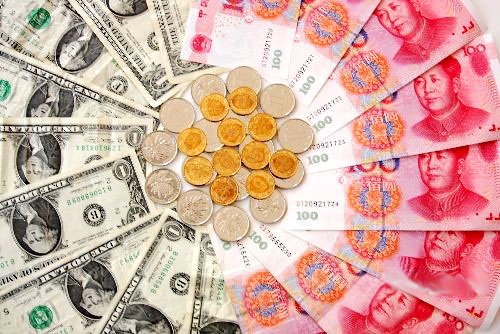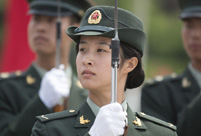Foreign exchange, interest rate and capital account reforms in China may achieve decisive results by 2020
China's central bank is expected to speed up currency reform.The roadmap for China's foreign exchange reforms has now come into focus as the nation recently wrapped up its landmark Third Plenum, which outlined the blueprint that is set to shape the direction of economic reforms in the world's second-largest economy for the next decade.
China vows to "improve the market-based yuan exchange rate formation mechanism, speed up the marketisation of interest rates and accelerate the implementation of yuan capital account convertibility", according to the detailed reform plan made public on November 15th by the Communist Party of China (CPC).
While some Western observers claimed that there was nothing new in the statement and it was only a repetition of the Chinese central government's long-standing position, they might not have studied the entire document related to China's economic reforms, or they might just look at each part in isolation. They have missed one critical point.
The central point of China's new economic reform agenda, in the authors' eyes, is "allowing the market to play a decisive role in resource allocation and giving better play to the role of government". The "decisive" role of the market is a major initiative in new wording that may lead to broad positive changes in China's economy, including those in foreign exchange rate mechanism, interest rate system and capital account convertibility.
If those China doubters correlate the statement about the market's decisive role with that concerning the foreign exchange reforms, they would have painted a different picture.
In the authors' opinion, the reiterations are a clear sign that the Chinese new leadership's commitment to more market-oriented exchange rate, interest rate and capital account reforms is firm, and the pace of the reforms will probably accelerate. These decisions approved by China's twice-a-decade Third Plenum have given an apparent indication of the direction of China's future foreign exchange reforms, namely, to move toward a more open and liberalized market-based regime with less government intervention.
Specifically, China's central bank is expected to speed up currency reform and gradually give the market a decisive role in setting the yuan's exchange rate.
This is evidenced by the recent announcement made by PBOC Governor Zhou Xiaochuan, who said that the PBOC would "basically exit" from regular intervention on the currency market, going further than in his previous comments when he had said it would "reduce" intervention.
However, such reform cannot happen overnight. Rather, it will only come in phases. The PBOC will next further widen the yuan's daily trading band after it was enlarged last year to 1 percent from the previous 0.5 percent to increase the two-way flexibility of the currency. In the long run, the yuan's trading limit will likely be abandoned to allow the exchange rate to float more freely based on a unified onshore and offshore trading of the currency.
In terms of the interest rate reform, the pace will probably quicken in the wake of the Third Plenum. Following the elimination of the floor on lending rates in July this year, the long-awaited deposit insurance system is expected to be established in the near term paving the way for freeing up deposit rates, which international experience demonstrates is the final step in liberalizing interest rates. The reform will be conducted step by step, and the authors expect China to realize liberalization of interest rates in three to five years.
Realizing the capital account convertibility is perhaps the most delicate balancing act among the many reforms in the financial sector that China needs to pull off, as it requires to be based on the aforementioned reforms on exchange rates and interest rates and will have a series of profound, far-reaching influences both within and outside China.
The pace of capital account liberalization in China has evidently accelerated since 2012. By the IMF standards, 85 percent of sub-items under China's capital account are now above the basically convertible level, with no completely inconvertible items.
Capital account reform is expected to enjoy a faster tempo, given that China has pledged to "accelerate" the implementation of yuan capital account convertibility in its new reform agenda, going further than in its previous statements of "gradually realizing" capital account convertibility.
As with the rate reforms, freeing up the Chinese capital account would also come in stages.
The authors believe that China will first liberalize cross-border capital flows and increase the level of convertibility in banking transactions. The quotas for the QFIIs and QDIIs are expected to be further expanded, and then the volume limits scrapped to allow foreign investors greater access to Chinese capital markets and Chinese investors to global markets. Liberalization in terms of cross-border lending and equity portfolio investment will come in later phases.
A robust regime for macromanaging foreign debt and capital flows will be put in place to ensure China's financial stability before the world's second-largest economy finally opens its capital account in a prudent manner.
Although the pace of this liberalization process may quicken after China made its reform pledges earlier this month, realizing the capital account convertibility is unlikely to happen anytime soon. It is the most delicate balancing act among the many reforms in China's financial sector and requires careful planning and prudent implementation. The grand reform plans may take years to come to fruition.
At this point, readers might have gotten a clearer picture of the roadmap for China's exchange rate, interest rate and capital account reforms over the coming years.
While no specific timeline has been outlined for these very reforms, China did promise to achieve "decisive results" in its reform push in key areas by 2020, according to the communique issued after the Third Plenum. The aforementioned reforms are beyond all questions the major items on China's economic reform agenda.
China is moving toward the next stage of development, and its foreign exchange reforms are poised to get in the fast lane. When the 13th Five-Year Plan (2016-2020) of the world's fastest-growing economy comes to an end, the next China will come into focus.
Shi Mingshen is the founder of the Securities Times in China and former first deputy head of the economic department at People's Daily.
 Chinese Kung Fu charms Silicon Valley
Chinese Kung Fu charms Silicon Valley
 Tranquil Yankou ancient town
Tranquil Yankou ancient town
 Lake Geneva: A show of swans
Lake Geneva: A show of swans
 Beautiful sunset over the Irtysh River
Beautiful sunset over the Irtysh River
 Qingjing Mosque: Witness of the ancient Maritime Silk Road
Qingjing Mosque: Witness of the ancient Maritime Silk Road
 Neiliansheng – more than 100 years of fashion
Neiliansheng – more than 100 years of fashion
 Golden retriever feeds baby African lions
Golden retriever feeds baby African lions
 Strange rocks in Lama Mountain
Strange rocks in Lama Mountain
 First overseas "China-standard" electric railway laid
First overseas "China-standard" electric railway laid
 College graduate launches organic agricultural cooperative in hometown
College graduate launches organic agricultural cooperative in hometown
 Opening ceremony of 67th Cannes Film Festival
Opening ceremony of 67th Cannes Film Festival Pulse of Xiamen - Int'l Yoga art festival in May
Pulse of Xiamen - Int'l Yoga art festival in May Photo story: Life of a scrap metal recycle worker
Photo story: Life of a scrap metal recycle worker Training of the PLA's first female honor guard
Training of the PLA's first female honor guard China's 10 must-see animations
China's 10 must-see animations Female bodybuilders show their beauty of fitness
Female bodybuilders show their beauty of fitness A taste of Harbin cuisine
A taste of Harbin cuisine A bite of Jiang Nan
A bite of Jiang Nan Who is China's campus beauty queen?
Who is China's campus beauty queen? 8 great movies to watch with your mom
8 great movies to watch with your mom China's most luminous celebrities
China's most luminous celebrities Newly recruited police in Hetian hold drill
Newly recruited police in Hetian hold drill  Bird-men compete flying in Hong Kong
Bird-men compete flying in Hong Kong  The 'Chinese Dad'
The 'Chinese Dad' Shanghai locals bid farewell to childhood memories
Shanghai locals bid farewell to childhood memories